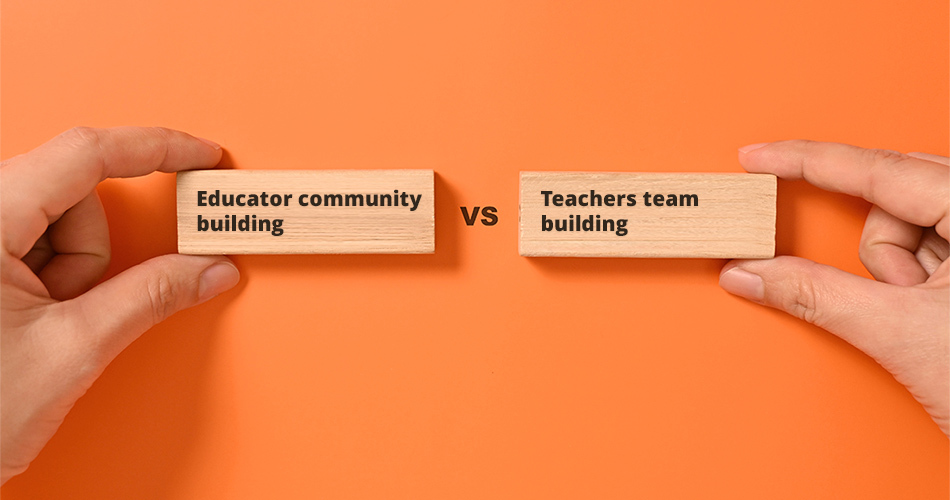Networking is essential for teacher collaboration, professional development, and student success. While these two terms (educator community building and teacher-team-building) are often used synonymously, they are not the same: they have different purposes, structures, and final aims. Comprehending these differences can assist educational institutions in forming better cooperation strategies for trainers.
What is educator community building?
Building an educator community is simply creating a community of educators who help each other with resources, thoughts, and experiences. It targets professional long-term relationships that cross institutional borders and allow teachers to become co-agents for each other’s growth.
Essential features of educator community development
- Shared purpose: Educators connect around mutual interests, values, or aims: improving techniques for instruction, exchanging ideas about new pedagogical approaches, child advocacy, and educational reform.
- Collaboration and learning: Communities are built around sharing knowledge, peer mentorship, and professional development opportunities.
- Long-term growth: Community building involves longer-term engagement in which educators support each other over time.
- Open participation: Membership is often fluid, inviting participation by teachers from different schools, districts, and types of education.
Examples of educator community building
- Websites like TeachersConnect where users can collaborate on forums, exchange resources, and ask for suggestions.
- National organizations like the National Education Association (NEA) or regional teacher organizations.
- The informal, like social media communities or teacher workshops.
Why to build educator community?
- High-quality professional development: Access to knowledge and ideas and an introduction to innovative teaching practices.
- Peer support: Teachers undoubtedly benefit from emotional support, mentorship, and shared problem-solving.
- Driving systemic change and innovations: Communities equip teachers to advocate for systemic changes and innovations in education.
- Resource sharing: Educators can use the ability to share everyone’s teaching materials, strategies, and tools that can save time and improve classroom outcomes.
- Shared perspectives: Educators from various parts of the world can share their own contexts, adapting practice to their students and communities.
The importance of educator communities today
In a world that is becoming more and more digital traffic, educator communities are essential. The emergence of online platforms enables teachers to communicate around geographical borders, supporting an international sharing of ideas and practices. Educators struggling with similar questions — like how to teach effectively online or address students’ different needs in the same classroom — can work together to discover best practices. A platform like TeachersConnect is a crucial cog in this machine, creating a digital ecosystem for teachers to teach, share files, and grow together. Through such connections, teachers can be aware of emerging trends, tools, and methodologies that confirm that they offer quality education to their students.
What is teacher team building?
Teacher team building simplifies the collaboration of educators in one school or one organization. It stresses collaboration, trust, and reaching specific institutional goals — improving student outcomes or rolling out new initiatives, for example.
What teacher-team-building looks like
- Team goals: Teacher teams are often organized around specific goals determined by their school or administration.
- Defined roles: Team members have well-defined roles and responsibilities.
- Concentrated collaboration: Teams plan on shared projects — for example, curriculum design, student intervention plans, or extracurricular activities.
- Organized: Activities are usually done through team meetings, workshops, or collaborative planning sessions.
- Accountability: Teacher teams frequently measure success by what they can achieve through student performance metrics.
Teacher-team-building examples
- Collaborative groups among grade-level or subject-area teams to align lesson plans or assessments.
- Experience-based Professional Learning Communities (PLCs) approach that addresses common teaching challenges.
- School leadership organizes team-building exercises to communicate skills and increase collaboration.
- Interdisciplinary project work in cross-functional teams where subject-expert teachers from different disciplines collaborate on student learning.
- Where mentorship programs have more seasoned teachers shepherd newer colleagues to bolster the overall team.
Here are some benefits of the teacher-team-building.
- Increased efficiency: Collaboration can save time, allowing teachers to share lesson plans and resources with one another.
- Find solutions that enhance student outcomes: Teams collaborate to discover best practices that promote student success.
- Better trust and morale: Team-building creates communication and relationship-building, minimizing workplace stress and improving dynamics.
- Consistent quality of teaching: Teams create cohesion across classrooms concerning teaching methods, grading, and expectations.
- Collective problem-solving: Teachers can collaboratively troubleshoot challenges experienced at their schools, such as students misbehaving in the classroom or not feeling engaged in lessons.
Teacher teams in schools — how this has transformed schools in the 21st century?
Teams of teachers are needed to solve any specific problem. With classrooms becoming more diverse and learning methods changing, teams can adapt swiftly to execute new initiatives particularly. From raising literacy rates to incorporating technology into the curriculum, teacher teams create a forum to experiment with different approaches, assess outcomes, and replicate what works.
Educator community building and teacher-team-building: what’s the difference?
They are both focused on teacher support but are distinctly different in terms of their scope, their focus, and their long-term effect. The table below outlines the differences in a nutshell:
| Aspect | Educator community building | Teacher-team-building |
|---|---|---|
| Scope | Broader, includes educators across organizations | Focused on teachers within the same school |
| Goal | Professional growth and shared learning | Achieving specific school goals |
| Duration | Long-term and ongoing | Often short-term or project-based |
| Structure | Informal and flexible | Formal and structured |
| Collaboration focus | Knowledge sharing and innovation | Task-oriented and outcome-driven |
| Membership | Open and voluntary | Defined by school leadership |
| Outcomes | Innovation, advocacy, and skill-sharing | Improved team efficiency and outcomes |
How to have the best of both worlds for the highest impact?
Combining both educator community building and teacher-team-building to meet the needs of schools and education institutions. If done well, they can create an environment that supports teachers in achieving access goals and helps them grow as professionals.
- Use educator communities for professional learning
Advocate for teachers to affiliate with educator communities beyond the building TeachersConnect, for instance, is a platform where educators can seek mentorship, share resources, and discuss the improvement of their practice. - Encourage teacher teams for school-targeted projects
Organize teams of teachers who work together on goals like curriculum design, assessment alignment, or student interventions. Offer continuous combined workouts so trust communication, and motivation are developed. - Integrate external communities with internal teams
Schools can inspire teachers to apply what they learn in educator communities with their teams. For example, online educator professional development and community activities can be directly transferred to classroom teams to assist in reaching desired outcomes. However, platforms like TeachersConnect can be a bridge that provides actionable insights that local teams could leverage. - Encourage constant communication
Even as teams work on specific projects, keeping the lines of communication between educators open helps fill in the gaps and facilitate learning. Collaboration can be assisted through regular check-ins, group meetings, or workshops. - Measure and celebrate success
Celebrating successes is vital to maintaining engagement in both communities and teams. Schools can measure the effect of teacher teams and communities in relation to student outcomes, professional growth, or innovative practices. Honor achievements through employee recognition events, awards, or sharing stories of impact.







